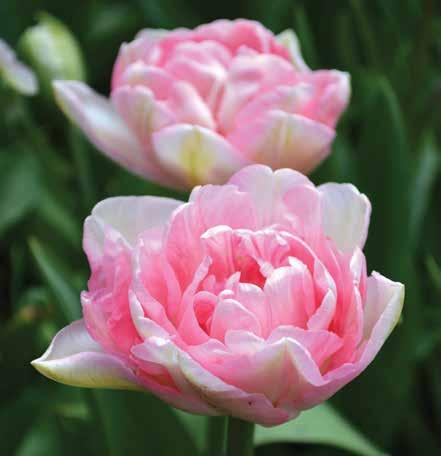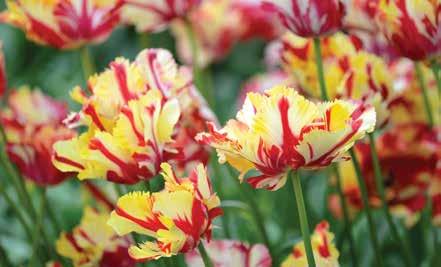
3 minute read
Plant Tulips in Fall
Plant Tulips in the Fall
planting the promise of spring with spring-blooming tulip bulbs
As the summer plants fade and temperatures cool, many of us are still working from or staying at home and looking out the window daily at our yards. With thoughts of the winter ahead, now is the time to plant some bright colors and patterns for next spring. Now is the time for tulip bulbs!
Below is a simple guide to help you navigate the world of tulips. These bulbs are purchased and planted now and can be a relatively inexpensive way to bring bright splashes of color to your landscape next spring.
Different Types of Tulips
Darwin Hybrid Tulips
Darwin hybrids produce large, showy flowers with a classic tulip shape: broad toward the base and narrower at the top. These come in a wide range of colors and stand approximately 20 to 28” tall with long, graceful stems that are ideal for cut flower arrangements. Darwin hybrid tulips are one of the best types for naturalizing, which means they often bloom for more than one year.
Botanical/Species Tulips
This group of tulips is closest in appearance to the original tulips which first grew in Central Asia— meaning it has not been significantly hybridized. Because of this, it naturalizes especially well and the short, small blooms will have your landscape looking colorful in spring for many years to come.
Bunch Flowering Tulips
With a self-explanatory name, bunch flowering tulips produce several flower heads from one bulb. The flowers are sometimes smaller than single flowering tulips, but the mass of color they create can really make an impact. Double Tulips
Multi-petaled blooms resembling a peony or English garden rose give double tulips an elegantly full look in both the garden and the vase.
Parrot Tulips
Parrot tulips are some of the most exotic and unique looking tulips. Each blossom is a work of art! A parrot tulip’s petals are its most identifiable feature because they are adorned with frills, puckers, ruffles and divots. This unique texture seems to amplify the stunning colors, and the shape of the flower heads change as the blooms mature.
How to Plant
In the Kansas City area, late September through October is the optimal time to plant tulips and other spring blooming bulbs. To plant, rake aside any mulch in the planting area and dig a hole for each bulb. Traditional advice dictates each hole be about six inches deep, but a 2011 research study from Cornell University proved that gardeners can also have success by “top planting” which involves loosening the soil about two inches deep, placing the bulbs on top of the soil and covering them with a two to four inch layer of mulch. Either way, bulbs should be spaced according to the package instructions. Adding half a tablespoon of bone meal or Espoma Bulb Tone at the bottom of each hole is optional, but can improve the plant’s vigor in following years if you’re planting tulips that are known to perennialize. Place the bulb at the bottom of the hole with the pointy end pointing up toward the sky, then fill the soil back in on top of the bulb. Rake any mulch back over the top of the area, and you’re finished!
In the spring, after tulips and other spring blooming bulbs are finished with their colorful show, it’s important to leave the green foliage alone for several weeks until it starts to yellow and dry up. The bulb draws nutrients from the foliage and will use those stores to bloom again the following year, if it’s a variety that tends to perennialize.
If you’re short on time or have no idea where to start, a few of my favorite bulbs are Angelique Tulip Angelique Double Pink
Tulip Flaming Parrot

(pink), Golden Apeldoorn (yellow), Red Impression (red) and Pays Bas (white).
No matter which type of tulip you decide to plant, those crisp, colorful blooms will be a breath of fresh air after our upcoming cold, Midwestern winter. So head out to the garden center and take your pick of tulips!
CHELSEA DIDDE RICE Gardening Enthusiast
When Chelsea isn’t at work as a senior communications specialist, she is an avid gardener who enjoys teaching people how easy it can be to garden. You may reach her at chelseadidde@gmail.com.










